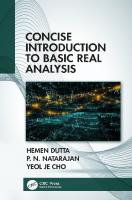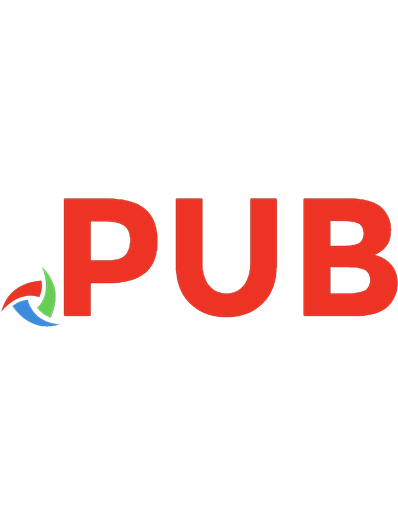Mathematical Analysis: A Concise Introduction [1 ed.] 9780470226766
A self-contained introduction to the fundamentals of mathematical analysis Mathematical Analysis: A Concise Introductio
525 120 9MB
English Pages 582 Year 2007
Table of contents :
Preface xi
Part I: Analysis of Functions of a Single Real Variable
1 The Real Numbers 1
1.1 Field Axioms 1
1.2 Order Axioms 4
1.3 Lowest Upper and Greatest Lower Bounds 8
1.4 Natural Numbers, Integers, and Rational Numbers 11
1.5 Recursion, Induction, Summations, and Products 17
2 Sequences of Real Number V 25
2.1 Limits 25
2.2 Limit Laws 30
2.3 Cauchy Sequences 36
2.4 Bounded Sequences 40
2.5 Infinite Limits 44
3 Continuous Functions 49
3.1 Limits of Functions 49
3.2. Limit Laws 52
3.3 One-Sided Limits and Infinite Limits 56
3.4 Continuity 59
3.5 Properties of Continuous Functions 66
3.6 Limits at Infinity 69
4 Differentiable Functions 71
4.1 Differentiability 71
4.2 Differentiation Rules 74
4.3 Rolle's Theorem and the Mean Value Theorem 80
5 The Riemann Integral I 85
5.1 Riemann Sums and the Integral 85
5.2 Uniform Continuity and Integrability of Continuous Functions 91
5.3 The Fundamental Theorem of Calculus 95
5.4 The Darboux Integral 97
6 Series of Real Numbers I 101
6.1 Series as a Vehicle to Define Infinite Sums 101
6.2 Absolute Convergence and Unconditional Convergence 108
7 Some Set Theory 117
7.1 The Algebra of Sets 117
7.2 Countable Sets 122
7.3 Uncountable Sets 124
8 The Riemann Integral II 127
8.1 Outer Lebesgue Measure 127
8.2 Lebesgue's Criterion for Riemann Integrability 131
8.3 More Integral Theorems 136
8.4 Improper Riemann Integrals 140
9 The Lebesgue Integral 145
9.1 Lebesgue Measurable Sets 147
9.2 Lebesgue Measurable Functions 153
9.3 Lebesgue Integration 158
9.4 Lebesgue Integrals versus Riemann Integrals 165
10 Series of Real Numbers II 169
10.1 Limits Superior and Inferior 169
10.2 The Root Test and the Ratio Test 172
10.3 Power Series 175
11 Sequences of Functions 179
11.1 Notions of Convergence 179
11.2 Uniform Convergence 182
12 Transcendental Functions 189
12.1 The Exponential Function 189
12.2 Sine and Cosine 193
12.3 L.' Hôpital's Rule 199
13 Numerical Methods 203
13.1 Approximation with Taylor Polynomials 204
13.2 Newton's Method 208
13.3 Numerical Integration 214
Part II: Analysis in Abstract Spaces
14 Integration on Measure Spaces 225
14.1 Measure Spaces 225
14.2 Outer Measures 230
14.3 Measurable Functions 234
14.4 Integration of Measurable Functions 235
14.5 Monotone and Dominated Convergence 238
14.6 Convergence in Mean, in Measure, and Almost Everywhere 242
14.7 Product Ϭ-Algebras 245
14.8 Product Measures and Fubini's Theorem 251
15 The Abstract Venues for Analysis 255
15.1 Abstraction I: Vector Spaces 255
15.2 Representation of Elements; Bases and Dimension 259
15.3 Identification of Spaces: Isomorphism 262
15.4 Abstraction II: Inner Product Spaces 264
15.5 Nicer Representations: Orthonormal Sets 267
15.6 Abstraction III: Norrned Spaces 269
15.7 Abstraction IV: Metric Spaces 275
15.8 LP Spaces 278
15.9 Another Number Field: Complex Numbers 281
16 The Topology of Metric Spaces 287
16.1 Convergence of Sequences 287
16.2 Completeness 291
16.3 Continuous Functions 296
16.4 Open and Closed Sets 301
16.5 Compactness 309
16.6 The Normed Topology of Rd 316
16.7 Dense Subspaces 322
16.8 Connectedness 330
16.9 Locally Compact Spaces 333
17 Differentiation in Normed Spaces 341
17.1 Continuous Linear Functions 342
17.2 Matrix Representation of Linear Functions 348
17.3 Differentiability 353
17.4 The Mean Value Theorem 360
17.5 How Partial Derivatives Fit In 362
17.6 Multilinear Functions (Tensors) 369
17.7 Higher Derivatives 373
17.8 The. Implicit Function Theorem 380
18 Measure, Topology, and Differentiation 385
18.1 Lebesgue Measurable Sets in Rd 385
18.2 C-infty and Approximation of Integrable Functions 391
18.3 Tensor Algebra and Determinants 397
18.4 Multidimensional Substitution 407
19 Introduction to Differential Geometry 421
19.1 Manifolds 421
19.2 Tangent Spaces and Differentiable Functions 427
19.3 Differential Forms, Integrals Over the Unit Cube 434
19.4 k-Forms and Integrals Over k-Chains 443
19.5 Integration on Manifolds 452
19.6 Stokes' Theorem 458
20 Hilbert Spaces 463
20.1 Orthonormal Bases 463
20.2 Fourier Series 467
20.3 The Riesz Representation Theorem 475
Part III: Applied Analysis
21 Physics Background 483
21.1 Harmonic Oscillators 484
21.2 Heat and Diffusion 486
21.3 Separation of Variables, Fourier Series, and Ordinary Differential Equa-tions 490
21.4 Maxwell's Equations 493
21.5 The Navier Stokes Equation for the Conservation of Mass 496
22 Ordinary Differential Equations 505
22.1 Burwell Space Valued Differential Equations 505
22.2 An Existence and Uniqueness Theorem 508
22.3 Linear Differential Equations 510
23 The Finite Element Method 513
23.1 Ritz-Galerkin Approximation 513
23.2 Wealth Differentiable Functions 518
23.3 Sobolev Spaces 524
23.4 Elliptic Differential Operators 532
23.5 Finite Elements 536
Conclusion and Outlook 544
Appendices
A Logic 545
A.1 Statements 545
A.2 Negations 546
B Set Theory 547
B. 1 The Zermelo-Fraenkel Axioms 547
B.2 Relations and Functions 548
C Natural Numbers, Integers, and Rational Numbers 549
C.1 The Natural Numbers 549
C.2 The Integers 550
C.3 The Rational Numbers 550
Bibliography 551
Index 553
![Mathematical Analysis: A Concise Introduction [1 ed.]
9780470226766](https://dokumen.pub/img/200x200/mathematical-analysis-a-concise-introduction-1nbsped-9780470226766.jpg)


![Introduction to Mathematical Analysis I [1]](https://dokumen.pub/img/200x200/introduction-to-mathematical-analysis-i-1.jpg)



![A Concise Introduction to Mathematical Logic [3 ed.]
9781441912206, 9781441912213, 1441912207](https://dokumen.pub/img/200x200/a-concise-introduction-to-mathematical-logic-3nbsped-9781441912206-9781441912213-1441912207.jpg)


